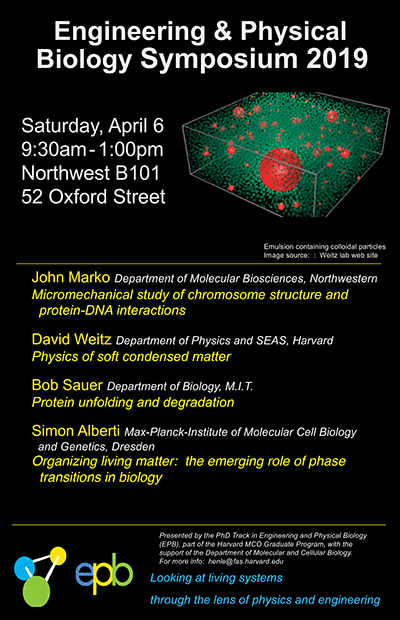On Saturday, April 6, the annual Engineering and Physical Biology (EPB) Symposium will be held in Room B101 of the Northwest Building, 52 Oxford St. Speakers from constituent fields -Physics, Engineering and the Biological Sciences – will present significant recent findings and theorizations.
As in the past, the EPB Symposium day has been organized to bring together students and faculty from several Harvard areas (OEB, CCB, MCB, Physics and SEAS) with outstanding visiting scholars. EPB, now in its twelfth year as a PhD track for students wishing to “probe living systems through the lens of physics and engineering,” is part of the MCO Graduate Program.
The day will be divided into two parts. The morning (9:30am – 1:00pm) will be a public symposium featuring four visiting faculty. (See poster.) The event is free, the public is welcome to attend, and the talks should be of wide interest to the Harvard science community.
The afternoon will feature graduate student presentations and discussions in a more intimate setting that should promote the cross-fertilization of disciplines that EPB encapsulates. (These sessions will not be open to the general public.)
Work at physics and engineering interface is rapidly becoming an established part of the life sciences. EPB particularly welcomes members of the MCB community to engage with these speakers working on the frontiers of physical biology.
Morning Schedule – Public Event
9:30 – 1:00 Morning Session, open to the public, Northwest Building B101
9:30 – 10:15 John Marko, Department of Molecular Biosciences, Northwestern “Micromechanical study of chromosome structure and protein/DNA interactions”
10:15 – 11:00 David Weitz, Department of Physics and SEAS, Harvard “Physics of soft condensed matter”
11:00 – 11:30 – Coffee Break
11:30 – 12:15 Bob Sauer, Department of Biology, M.I.T. “Protein unfolding and degradation”
12:15 – 1:00 Simon Alberti, Max Planck Institute of Molecular Cell Biology and Genetics, Dresden “Organizing living matter: the emerging role of phase transitions in biology”
For more information, please contact: Jim Henle Program Administrator Engineering and Physical Biology Harvard University henle@fas.harvard.edu 617-495-4477

by Jim Henle



